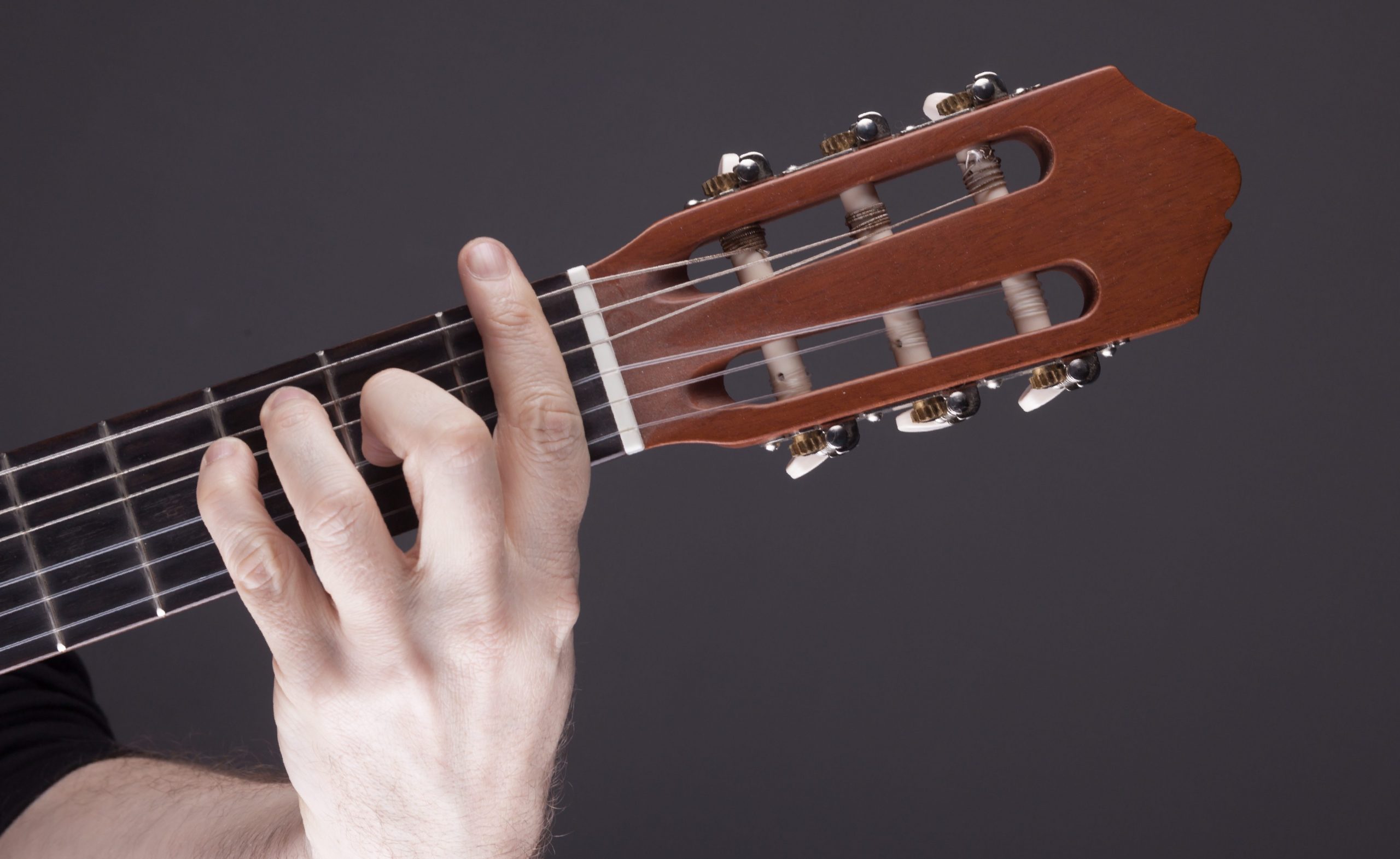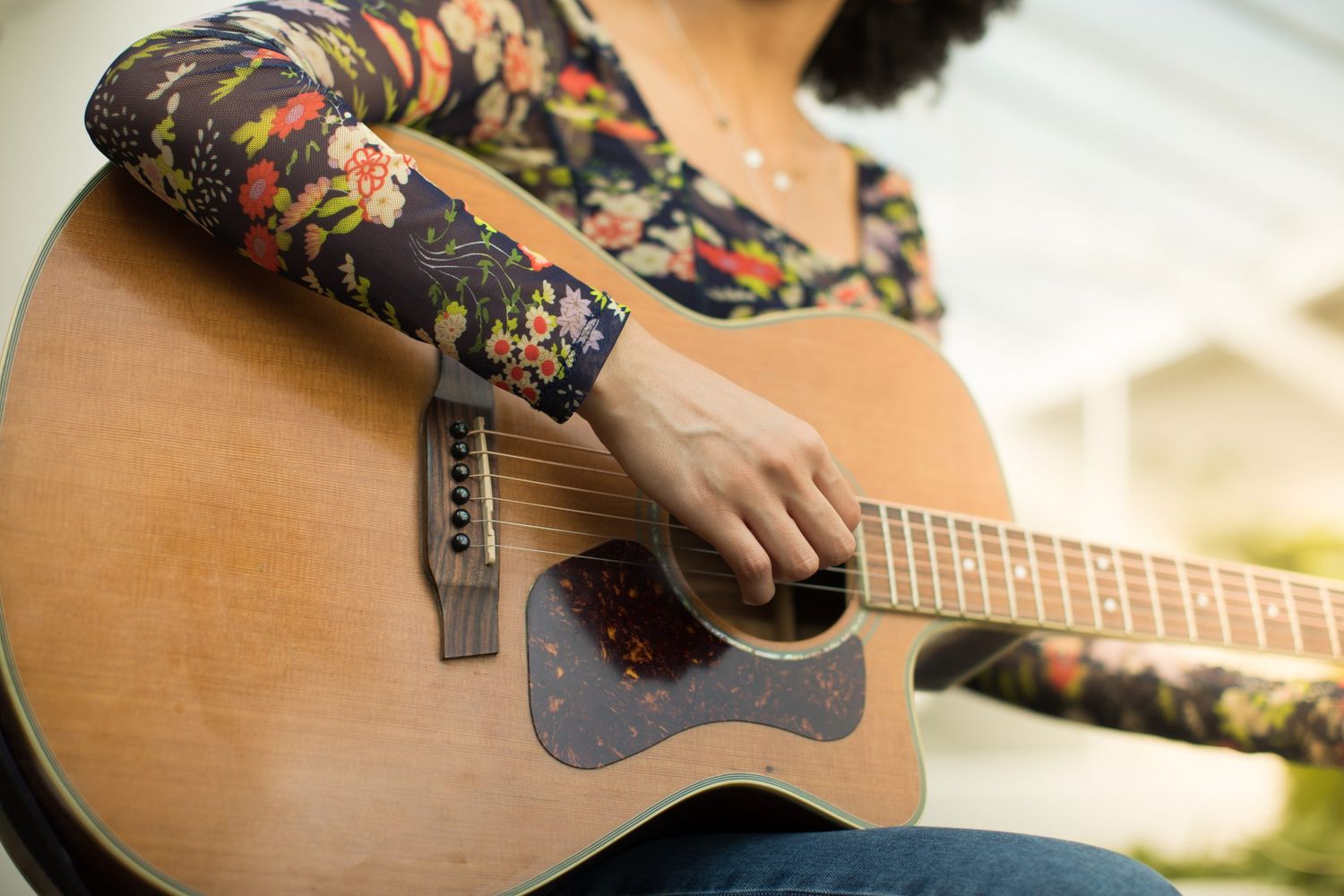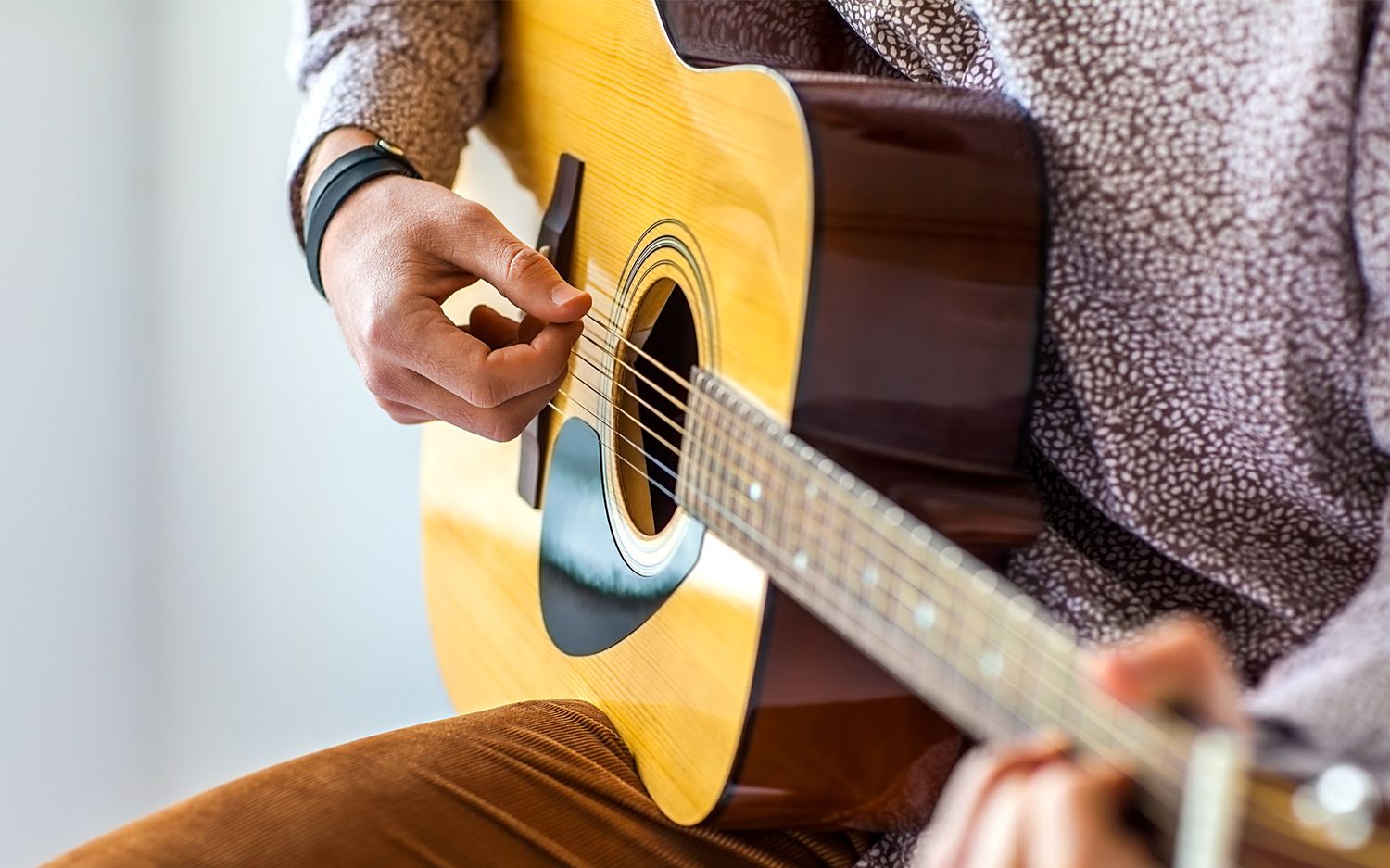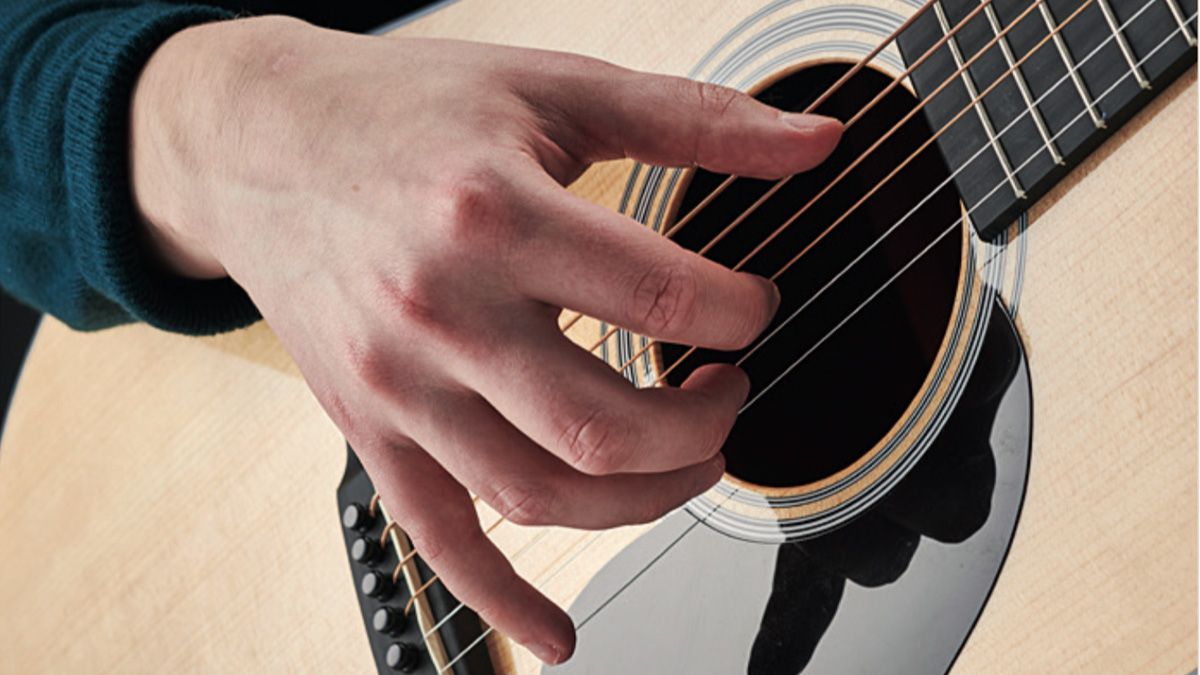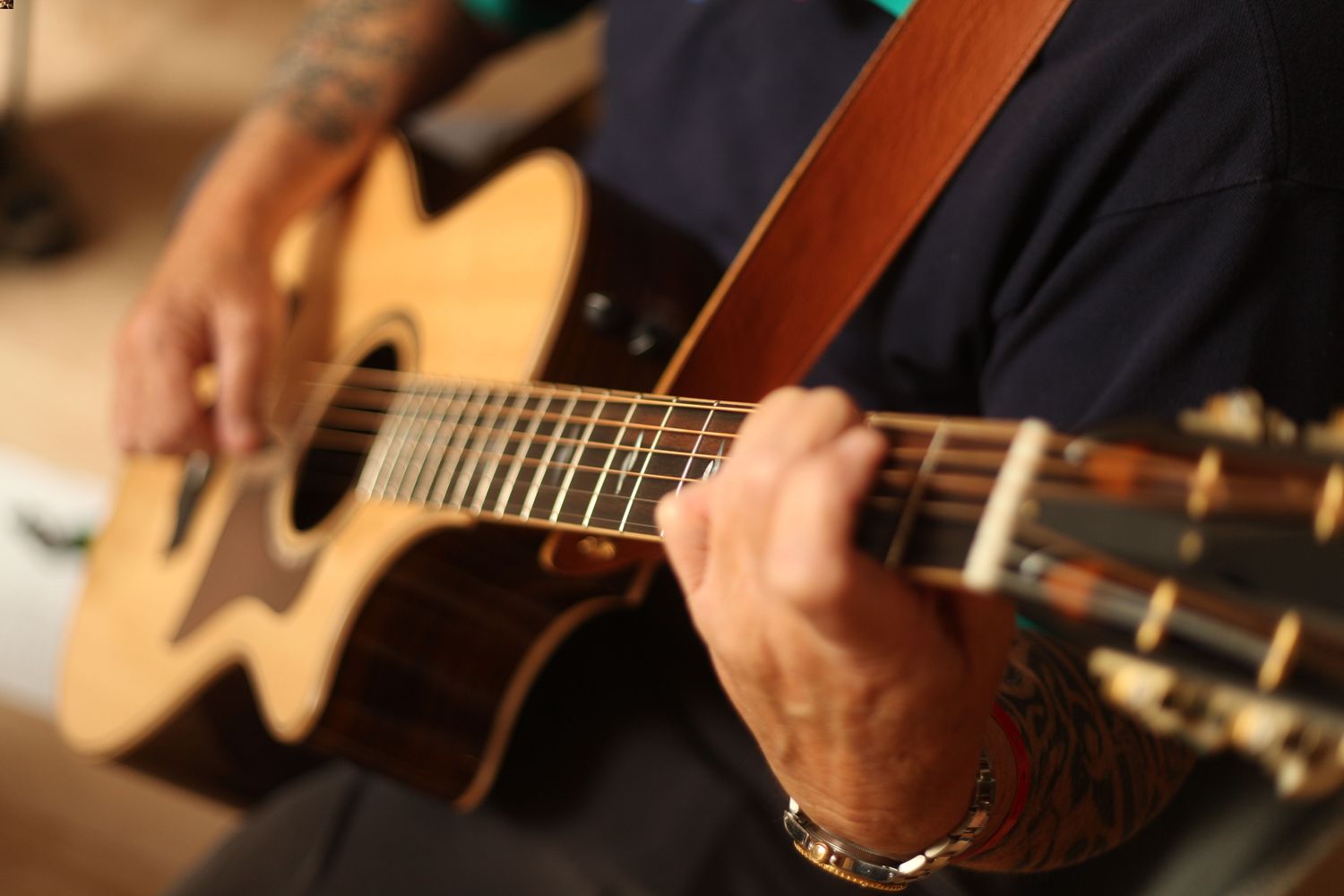Home>Instruments>Guitar>How To Play Guitar For Dummies
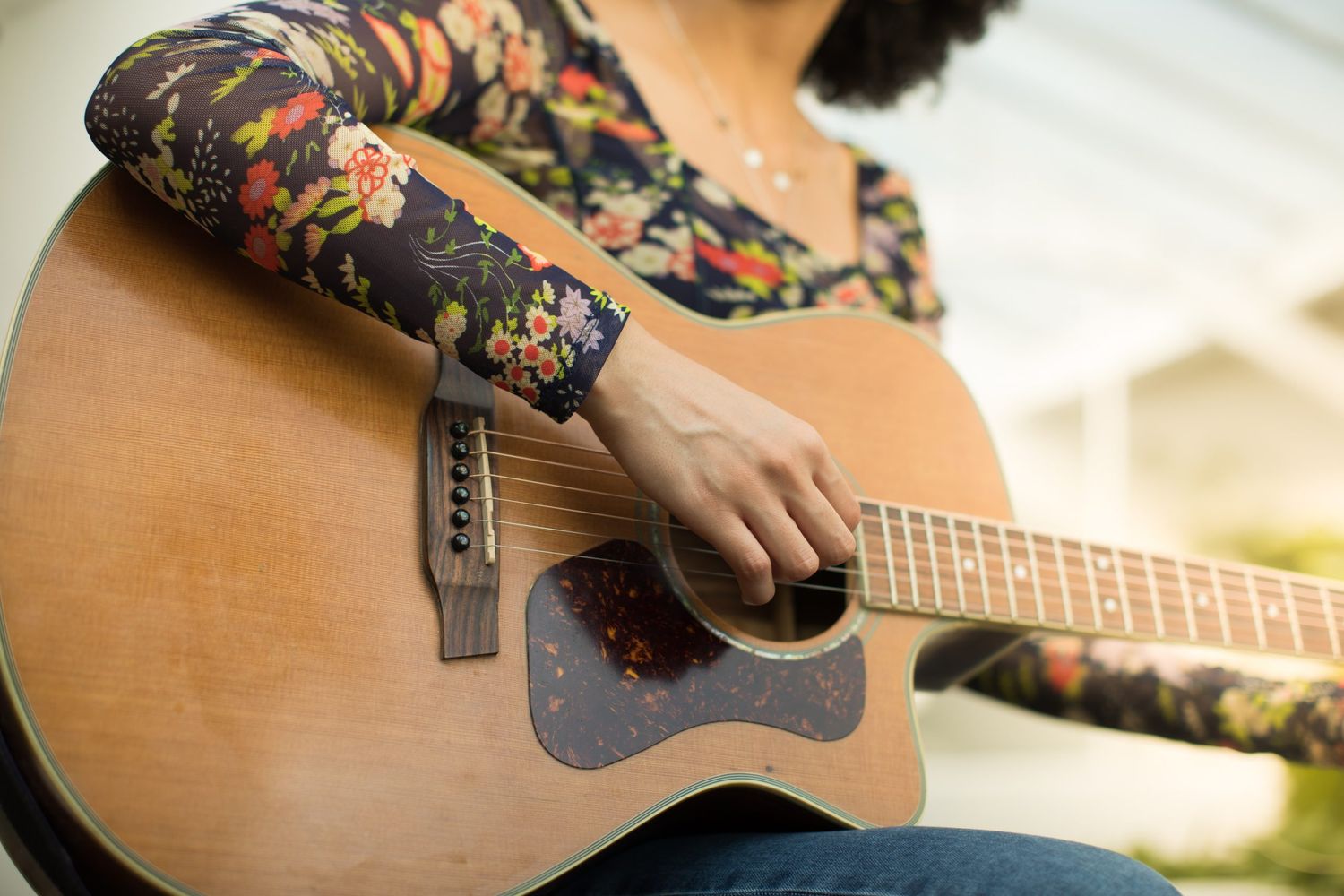

Guitar
How To Play Guitar For Dummies
Published: February 13, 2024
Learn how to play guitar with easy step-by-step instructions in "Guitar For Dummies." Master chords, scales, and techniques to become a pro!
(Many of the links in this article redirect to a specific reviewed product. Your purchase of these products through affiliate links helps to generate commission for AudioLover.com, at no extra cost. Learn more)
Table of Contents
- Unlocking the World of Guitar Playing
- Embarking on Your Musical Journey
- Finding Your Perfect Pitch
- Mastering Comfort and Control
- Unlocking the Harmonic Palette
- Decoding the Language of Guitar Music
- Rhythmic Foundations of Guitar Playing
- Unleashing Melodic Flourishes
- Diverse Pathways of Musical Expression
- Elevating Artistry Through Mastery
- Optimizing Your Musical Growth
- Navigating Challenges on Your Guitar Journey
- Embracing the Musical Odyssey
Introduction
Unlocking the World of Guitar Playing
So, you’ve decided to embark on a musical journey and learn how to play the guitar. Congratulations! You’re about to dive into a world of creativity, self-expression, and endless sonic possibilities. Whether you’ve been inspired by the electrifying riffs of rock legends, the soul-stirring melodies of acoustic ballads, or the finger-twisting virtuosity of guitar maestros, learning to play this iconic instrument is an incredibly rewarding endeavor.
The guitar has an unparalleled allure that has captivated music enthusiasts for generations. Its versatility allows you to strum soothing chords, unleash blistering solos, or create intricate fingerstyle arrangements. From intimate campfire sing-alongs to rocking out on stage in front of a roaring crowd, the guitar has the power to evoke emotions, connect people, and transcend cultural boundaries.
As you begin your guitar-playing journey, it’s important to approach this endeavor with an open mind and a sense of excitement. While mastering the guitar takes time, patience, and dedication, the process of learning and improving is an immensely fulfilling experience. Whether you dream of composing your own songs, jamming with friends, or simply serenading your loved ones, the guitar can be your faithful companion on a musical adventure.
Throughout this guide, you’ll delve into the fundamentals of playing the guitar, from understanding its anatomy and tuning to mastering essential chords and strumming patterns. You’ll also explore the art of reading guitar tablature, a universal language that unlocks a treasure trove of songs and musical ideas. Additionally, you’ll discover tips for honing your technique, troubleshooting common mistakes, and embarking on a journey of continuous improvement.
Whether you’re picking up the guitar for the first time or seeking to refine your skills, this guide will equip you with the knowledge and confidence to navigate the exciting world of guitar playing. So, grab your guitar, tune up, and get ready to unleash the melodious magic that lies within your fingertips. Let’s embark on this musical odyssey together!
Getting Started with Guitar Basics
Embarking on Your Musical Journey
Before diving into the intricacies of playing the guitar, it’s essential to familiarize yourself with the instrument itself. The guitar consists of various components, including the body, neck, fretboard, strings, and tuning pegs. Understanding the anatomy of the guitar will provide you with a solid foundation as you begin your musical exploration.
When selecting your first guitar, consider factors such as body size, neck width, and string action to ensure a comfortable playing experience. Acoustic guitars produce warm, resonant tones and are well-suited for strumming and fingerpicking, while electric guitars offer versatility in tone and are ideal for various musical styles, especially rock and blues.
Once you have your guitar in hand, it’s time to acquaint yourself with fundamental techniques. Proper posture and hand positioning are crucial for developing good playing habits and preventing strain or injury. Whether you choose to sit or stand while playing, maintain an upright yet relaxed posture, and position the guitar comfortably against your body.
As you acquaint yourself with the instrument, familiarize yourself with the names and functions of the guitar’s components. From the headstock to the bridge, each part plays a role in producing and shaping the guitar’s sound. Understanding these elements will not only deepen your appreciation for the instrument but also aid in future maintenance and customization.
As you begin your guitar journey, embrace the excitement of learning something new and the joy of creating music with your own hands. Remember, every accomplished guitarist started as a beginner, and the key to progress lies in consistent practice, patience, and a willingness to explore new musical horizons.
Now that you’ve acquainted yourself with the basics, it’s time to delve into the next step of your guitar-playing journey: tuning your instrument. By ensuring that your guitar is in tune, you’ll lay the groundwork for producing harmonious sounds and honing your ear for pitch. Let’s explore the art of tuning your guitar in the next section.
Tuning Your Guitar
Finding Your Perfect Pitch
One of the first and most crucial steps in your guitar-playing journey is ensuring that your instrument is properly tuned. Tuning your guitar not only ensures that it produces harmonious sounds but also trains your ear to recognize different pitches, a skill that is essential for playing in tune with other musicians and musical recordings.
Standard tuning for a six-string guitar, from the lowest pitch string to the highest, is EADGBE. To achieve this tuning, you can use a variety of tools, including electronic tuners, tuning forks, pitch pipes, or even tuning apps on your smartphone. Electronic tuners are particularly popular for their accuracy and ease of use, providing visual feedback to help you achieve precise tuning.
When tuning your guitar, start by adjusting the lowest-pitched string, the sixth string (E), to the correct pitch. You can use a reference pitch from a tuning source or another instrument to guide you. Once the sixth string is in tune, you can tune the remaining strings relative to it, using fretted notes or harmonics to ensure accuracy.
While tuning your guitar, it’s essential to develop a discerning ear and pay attention to the subtle differences in pitch. As you progress, you may explore alternate tunings, such as drop D tuning or open tunings, which can unlock new sonic possibilities and inspire fresh musical ideas.
Regularly checking and adjusting the tuning of your guitar is vital for maintaining consistent sound quality and playability. Factors such as temperature changes and string tension can cause the guitar to drift out of tune, so developing the habit of tuning your instrument before each practice session or performance is a valuable practice.
By mastering the art of tuning your guitar, you’ll lay a solid foundation for your musical pursuits and develop a keen sense of pitch and harmony. With your guitar in perfect tune, you’re now ready to explore the essential techniques of holding the guitar and pick, which will empower you to play with comfort and precision. Let’s delve into this fundamental aspect of guitar playing in the next section.
Holding the Guitar and Pick
Mastering Comfort and Control
As you prepare to make music with your guitar, it’s essential to establish a comfortable and ergonomic playing position. Whether you’re seated or standing, proper posture and hand positioning are key to developing a relaxed and sustainable playing technique.
When sitting, place the guitar on your dominant leg, ensuring that the instrument’s body rests against your torso. This position allows for easy access to the fretboard and promotes a natural hand position for fretting chords and notes. If you prefer to play while standing, consider using a guitar strap to position the instrument at a comfortable height, allowing for unrestricted movement and playability.
Next, focus on your fretting hand, the hand responsible for pressing down on the strings to produce different notes and chords. Position your fingers just behind the frets to ensure clear and resonant notes, and maintain a relaxed yet firm grip on the neck of the guitar. As you progress, pay attention to your finger placement and develop the dexterity to navigate the fretboard with ease.
Equally important is your picking hand, which controls the guitar pick or your fingers when plucking the strings. Hold the pick between your thumb and index finger, allowing a small portion of the pick to extend beyond your grip. Experiment with different pick angles and degrees of attack to discover the tonal nuances produced by varying your picking technique.
Developing a balanced and controlled playing technique will enable you to produce clear, articulate notes and chords while minimizing strain and tension. Remember, finding a comfortable and sustainable playing position is essential for enjoying extended practice sessions and performances without discomfort or fatigue.
With a solid grasp of holding the guitar and pick, you’re now ready to explore the foundational aspect of guitar playing: forming and transitioning between chords. In the next section, we’ll delve into playing your first chords and unlocking the harmonic potential of the guitar.
Playing Your First Chords
Unlocking the Harmonic Palette
As you begin your guitar journey, mastering fundamental chords is a pivotal step toward unlocking the instrument’s harmonic potential. Chords form the building blocks of countless songs across various musical genres, and learning to play them opens the door to creating captivating musical arrangements and accompaniments.
Commonly used chords such as C, G, D, E, and A are excellent starting points for novice guitarists. Each chord is formed by pressing down on specific strings and frets, producing a harmonious blend of notes when strummed together. While initially challenging, consistent practice and patience will yield the muscle memory and finger strength necessary to form chords cleanly and effortlessly.
When fretting chords, focus on positioning your fingers close to the frets and applying even pressure to produce clear and resonant notes. Strive for a relaxed hand position and avoid unnecessary tension, allowing your fingers to arch naturally and come down squarely on the strings. As you transition between chords, aim for smooth and seamless movements, gradually building the coordination and agility required for fluid chord changes.
Practicing chord transitions within simple progressions and song structures will reinforce your ability to switch between chords fluently. Start with straightforward songs that feature basic chord sequences, gradually progressing to more complex arrangements as your skills develop. Remember, the key to mastering chords lies in consistent practice, patience, and a willingness to embrace the learning process.
As you familiarize yourself with essential chords, you’ll discover the joy of strumming and creating melodic accompaniments to your favorite songs. Whether you aspire to strum along to folk tunes, rock out to classic anthems, or serenade with heartfelt ballads, mastering chords will empower you to express yourself through the captivating language of music.
Now that you’ve embarked on your chord-playing journey, it’s time to delve into the art of reading guitar tablature, a universal notation system that simplifies the process of learning and playing songs on the guitar. In the next section, we’ll explore the fundamentals of guitar tablature and how it can accelerate your musical progress.
Understanding Guitar Tablature
Decoding the Language of Guitar Music
For aspiring guitarists, understanding guitar tablature is akin to unlocking a treasure map that leads to a vast repertoire of songs and musical compositions. Guitar tablature, often abbreviated as “tab,” provides a visual representation of the guitar’s fretboard, allowing players to learn and play songs without the need for traditional sheet music notation.
Unlike standard musical notation, which requires knowledge of staff lines, note durations, and rhythmic values, guitar tablature simplifies the learning process by illustrating the string and fret positions where notes and chords are played. Each line in the tab represents a string on the guitar, while numbers on the lines indicate which frets to press down, facilitating the recreation of melodies, riffs, and chord progressions.
One of the key advantages of guitar tablature is its accessibility to beginners, enabling them to quickly grasp the finger positions and sequences required to play songs. This intuitive format allows aspiring guitarists to learn their favorite tunes, study iconic guitar solos, and explore diverse musical genres with relative ease.
While guitar tablature provides a valuable learning resource, it’s important to complement it with ear training and an understanding of rhythm and timing. Listening to recordings of songs and paying attention to the nuances of timing, dynamics, and expression will enrich your musical interpretation and elevate your playing to a higher level of artistry.
As you immerse yourself in the world of guitar tablature, you’ll find an abundance of online resources, books, and software that offer a vast library of tablature for songs spanning decades of musical history. Whether you’re drawn to classic rock anthems, timeless blues standards, or contemporary pop hits, guitar tablature serves as a gateway to embracing and mastering a diverse range of musical styles.
Now equipped with a foundational understanding of guitar tablature, you’re ready to delve into the essential skill of strumming patterns, which infuse rhythm and groove into your guitar playing. In the next section, we’ll explore the art of mastering basic strumming patterns and enhancing your musical expression.
Mastering Basic Strumming Patterns
Rhythmic Foundations of Guitar Playing
Strumming patterns form the rhythmic heartbeat of guitar music, infusing songs with energy, groove, and dynamic expression. Whether you’re accompanying vocals, playing instrumental melodies, or jamming with fellow musicians, mastering basic strumming patterns is essential for creating engaging and captivating musical performances.
When approaching strumming, it’s crucial to develop a sense of rhythm and timing. Begin by practicing steady downstrokes and upstrokes with your pick, maintaining a consistent tempo and focusing on producing clear and articulate strums. As you gain proficiency, experiment with accenting certain beats or adding syncopated rhythms to inject variety and flair into your playing.
Understanding rhythmic notation, such as time signatures and rhythmic subdivisions, will enhance your ability to interpret and execute strumming patterns accurately. Common time signatures, such as 4/4 and 3/4, dictate the number of beats in each measure and provide a framework for organizing strumming patterns within a song’s structure.
As you explore different musical genres, you’ll encounter a diverse array of strumming patterns, each contributing to the unique character and feel of the music. From the driving force of rock power chords to the laid-back sway of folk and blues rhythms, mastering various strumming patterns will expand your musical versatility and repertoire.
Transitioning between chords while maintaining a consistent strumming pattern is a fundamental skill that requires coordination and precision. Practice transitioning smoothly between chords while keeping the strumming pattern uninterrupted, gradually building the muscle memory and finger agility necessary for seamless chord changes.
As you hone your strumming skills, don’t hesitate to experiment with dynamics, muting techniques, and percussive elements to add depth and texture to your playing. Embracing the expressive potential of strumming patterns will elevate your musical performances and imbue your playing with personality and emotion.
With a solid grasp of basic strumming patterns, you’re now poised to explore the enchanting world of guitar riffs and licks, which add melodic intrigue and virtuosity to your playing. In the next section, we’ll delve into learning popular riffs and licks, unraveling the sonic tapestry of guitar music.
Learning Popular Riffs and Licks
Unleashing Melodic Flourishes
Popularized by iconic guitarists across a spectrum of musical genres, riffs and licks are melodic fragments that serve as captivating focal points within songs, solos, and instrumental compositions. Mastering these memorable musical phrases not only enhances your technical prowess but also infuses your playing with flair, personality, and melodic intrigue.
When approaching riffs and licks, it’s beneficial to start with timeless classics that have left an indelible mark on the guitar landscape. Iconic riffs from songs such as “Smoke on the Water,” “Sunshine of Your Love,” and “Sweet Child o’ Mine” are excellent entry points for delving into the art of crafting and performing memorable guitar phrases.
As you delve into learning popular riffs and licks, pay attention to the nuances of articulation, phrasing, and dynamics employed by the original performers. Emulate their expressiveness and infuse your rendition with your unique musical sensibilities, adding a personal touch to these celebrated musical motifs.
While mastering specific riffs and licks is a valuable pursuit, it’s equally important to develop the improvisational skills necessary for crafting your own melodic ideas. Understanding scales, modes, and melodic patterns will empower you to create original riffs and licks, fostering a sense of musical creativity and individuality in your playing.
Exploring diverse musical styles and genres will expose you to a rich tapestry of riffs and licks, each offering unique technical challenges and melodic inspirations. From the bluesy bends and slides of classic rock to the intricate fingerstyle licks of acoustic folk, embracing a broad spectrum of musical influences will expand your melodic vocabulary and enrich your playing.
As you delve into the world of riffs and licks, remember that precision, timing, and articulation are crucial for delivering these melodic flourishes with clarity and impact. Practice with attention to detail, gradually refining your technique and honing your ability to convey emotion and narrative through your melodic phrasing.
With a repertoire of popular riffs and licks at your fingertips, you’re now poised to explore the diverse landscape of guitar playing styles and techniques. In the next section, we’ll embark on a journey of discovering different styles of playing, from the soulful realms of blues to the high-energy realms of rock and beyond.
Exploring Different Styles of Playing
Diverse Pathways of Musical Expression
The world of guitar playing is a rich tapestry woven with diverse styles and genres, each offering a distinct sonic identity and expressive potential. Whether you’re drawn to the soulful laments of blues, the high-octane energy of rock, the rhythmic intricacies of jazz, or the evocative melodies of folk and classical music, exploring different playing styles opens the door to a boundless realm of musical expression.
Blues guitar playing, with its emotive bends, expressive vibrato, and soul-stirring phrasing, embodies the raw essence of human emotion and storytelling. Delve into the evocative world of blues scales, call-and-response motifs, and the expressive use of the pentatonic scale to cultivate a deep connection with the roots of blues music.
Rock guitar playing encompasses a wide spectrum of styles, from the thunderous power chords and searing solos of classic rock to the blistering riffs and technical prowess of heavy metal. Embrace the electrifying energy of rock by mastering palm muting, power chord progressions, and aggressive lead guitar techniques, immersing yourself in the dynamic spirit of rock and roll.
Jazz guitar, with its sophisticated harmonies, intricate chord voicings, and improvisational freedom, offers a playground for harmonic exploration and melodic ingenuity. Dive into the world of jazz standards, explore the nuances of chord melody playing, and unravel the complexities of jazz improvisation to expand your musical horizons.
Fingerstyle playing, characterized by the intricate interplay of melody, harmony, and bass lines, offers a captivating approach to solo guitar performance. Whether you’re drawn to the enchanting melodies of classical guitar compositions or the contemporary fingerstyle arrangements of acoustic virtuosos, fingerstyle playing invites you to explore the full potential of the guitar as a solo instrument.
As you immerse yourself in different playing styles, you’ll discover the unique techniques, tonal palettes, and expressive nuances that define each genre. Embrace the diversity of guitar music, allowing the distinct characteristics of each style to inspire and inform your playing, ultimately shaping your musical identity and artistic voice.
With a broadened perspective on guitar playing styles, you’re now prepared to further refine your technique and musicality. In the next section, we’ll delve into strategies for improving your technique, unlocking new levels of proficiency and artistry in your guitar playing journey.
Improving Your Technique
Elevating Artistry Through Mastery
Refining your technique is an ongoing journey that shapes the foundation of your musical expression and proficiency as a guitarist. By focusing on technical mastery, you can elevate your playing to new heights, unlocking a world of sonic possibilities and artistic fulfillment.
One fundamental aspect of improving technique is developing dexterity and strength in both hands. Regular practice of scales, arpeggios, and technical exercises enhances finger independence and agility, enabling you to navigate the fretboard with precision and fluidity. Dedicate time to targeted exercises that challenge your fingers, gradually expanding your reach and control over the instrument.
Attention to proper hand positioning and posture is essential for preventing tension and injury while playing. Maintain a relaxed yet poised posture, ensuring that your fretting hand and picking hand are positioned ergonomically for efficient and comfortable playing. By cultivating a mindful approach to physicality, you’ll lay the groundwork for sustainable and enjoyable practice sessions.
Listening critically to your playing and seeking constructive feedback from experienced musicians or instructors can provide valuable insights into areas for improvement. Embrace a spirit of openness and receptivity to feedback, using it as a catalyst for growth and refinement in your playing.
Exploring diverse musical genres and playing styles contributes to a well-rounded musical education and fosters adaptability in your playing. By immersing yourself in various genres, you’ll encounter a wide array of techniques, tonal palettes, and expressive nuances, enriching your musical vocabulary and broadening your artistic perspective.
Embracing the discipline of deliberate practice, characterized by focused, goal-oriented, and mindful rehearsal, accelerates your technical growth and musical development. Set specific objectives for each practice session, whether it’s mastering a challenging passage, refining your tone and dynamics, or internalizing complex rhythmic patterns.
As you commit to continuous improvement in your technique, remember that patience, persistence, and a spirit of curiosity are your allies on this journey. Celebrate the incremental victories and breakthroughs, and remain steadfast in your dedication to honing your craft and realizing your full potential as a guitarist.
With a steadfast commitment to improving your technique, you’re now poised to explore strategies for practicing effectively and maximizing your progress. In the next section, we’ll delve into tips for practicing with purpose and efficiency, optimizing your musical growth and development.
Tips for Practicing Effectively
Optimizing Your Musical Growth
Effective practice is the cornerstone of skill development and musical mastery. By implementing strategic approaches to your practice sessions, you can maximize your progress, deepen your understanding of the instrument, and cultivate a strong foundation for expressive and confident guitar playing.
Establish a consistent practice routine that aligns with your schedule and allows for regular, focused sessions. Whether it’s daily practice or several times a week, creating a structured practice schedule fosters discipline and facilitates steady improvement over time.
Set specific, achievable goals for each practice session, whether it’s mastering a new chord progression, refining a challenging riff, or improving your speed and accuracy. Clear objectives provide direction and motivation, guiding your efforts toward tangible progress and skill development.
Practice with deliberate focus, engaging in mindful rehearsal that prioritizes quality over quantity. Concentrate on the nuances of your playing, such as tone, dynamics, and articulation, and strive for precision and expressiveness in every note and phrase.
Utilize practice techniques such as slow, incremental practice, where you gradually increase tempo and complexity, to solidify muscle memory and technical proficiency. Breaking down challenging passages into manageable segments and progressively building speed and fluency fosters efficient learning and retention.
Embrace varied practice approaches, including technical exercises, repertoire study, ear training, and music theory exploration. Diversifying your practice regimen cultivates a well-rounded skill set and fosters a comprehensive understanding of music and guitar playing.
Record and review your playing to gain valuable insights into your progress and areas for improvement. Recording yourself provides an objective perspective on your performance, enabling you to identify strengths and weaknesses and track your growth over time.
Stay attuned to your physical and mental well-being during practice, taking breaks as needed and maintaining a balanced approach to intensity and duration. Practicing with mindfulness and self-care promotes sustained motivation and enjoyment in your musical pursuits.
Engage in collaborative practice experiences, such as playing with other musicians, jamming with friends, or seeking guidance from experienced mentors. Musical collaboration fosters creativity, adaptability, and camaraderie, enriching your musical journey and broadening your perspective on guitar playing.
By integrating these effective practice tips into your routine, you’ll optimize your musical growth, elevate your playing, and embark on a fulfilling and rewarding journey of continuous improvement and artistic expression.
Troubleshooting Common Mistakes
Navigating Challenges on Your Guitar Journey
As you progress in your guitar-playing journey, encountering challenges and setbacks is a natural part of the learning process. By identifying common mistakes and developing strategies to address them, you can overcome obstacles and continue advancing with confidence and resilience.
1. Inconsistent Timing and Rhythm:
Address timing issues by practicing with a metronome, focusing on maintaining a steady tempo, and internalizing rhythmic patterns. Counting out loud while playing can also reinforce a strong sense of timing and pulse.
2. Fretting Hand Tension:
Combat fretting hand tension by practicing relaxation exercises, such as finger stretches and gentle massage, to alleviate muscle tightness. Focus on maintaining a light but firm grip on the fretboard to facilitate fluid and effortless movement.
3. Inaccurate Chord Transitions:
Refine chord transitions by isolating challenging changes and practicing them in repetitive drills. Gradually increase the speed and accuracy of transitions, ensuring that each finger lands precisely on the target frets with minimal hesitation.
4. Strumming Hand Consistency:
Enhance strumming hand consistency by practicing with a muted or lightly fretted chord, allowing you to focus on the rhythmic precision and dynamics of your strumming. Experiment with varied strumming patterns and accents to develop a versatile and expressive strumming technique.
5. Lack of Focus and Concentration:
Combat distractions and lack of focus by establishing a dedicated practice space free from interruptions. Engage in mindfulness practices, such as deep breathing and visualization, to center your attention and foster a focused mindset during practice sessions.
6. Posture and Ergonomics:
Address posture-related issues by ensuring that your practice environment is ergonomically optimized. Use a supportive chair, maintain a balanced posture, and take regular breaks to prevent physical strain and discomfort during extended practice sessions.
7. Overlooking Music Theory and Ear Training:
Supplement your practice with music theory study and ear training exercises to deepen your understanding of harmony, melody, and rhythm. Develop a holistic approach to learning the guitar by integrating theoretical knowledge with practical application in your playing.
By acknowledging and troubleshooting common mistakes, you’ll fortify your foundation as a guitarist, surmounting challenges with tenacity and a proactive mindset. Embrace the learning process as a journey of growth and discovery, and celebrate the incremental victories that propel you toward musical excellence.
Conclusion
Embracing the Musical Odyssey
Congratulations on embarking on your guitar-playing journey! As you’ve delved into the fundamental aspects of guitar playing, from mastering chords and strumming patterns to exploring diverse musical styles and refining your technique, you’ve laid a solid groundwork for your continued growth as a guitarist.
Remember, learning the guitar is a dynamic and enriching pursuit that rewards dedication, patience, and a spirit of exploration. Embrace the challenges and triumphs along the way, knowing that each obstacle overcome and skill acquired contributes to your evolution as a musician.
As you progress, seek inspiration from the guitar greats who have left an indelible mark on the instrument’s history. Emulate their passion, creativity, and perseverance, allowing their musical legacies to guide and motivate you on your own path.
Embrace the joy of musical collaboration, whether it’s jamming with friends, joining a band, or seeking guidance from experienced mentors. Engaging with a community of fellow musicians enriches your musical journey, fostering camaraderie, creativity, and shared growth.
Above all, let your love for music and the guitar propel you forward, infusing your playing with authenticity, emotion, and personal expression. Whether you aspire to perform on stage, compose original music, or simply revel in the joy of playing for yourself, the guitar offers a boundless realm of creativity and self-discovery.
As you continue your odyssey as a guitarist, remember that the learning never truly ends. Embrace each practice session, performance, and musical encounter as an opportunity for growth and artistic fulfillment. Your journey as a guitarist is a testament to your passion for music and the transformative power of dedicated practice and unwavering dedication.
So, pick up your guitar, let the music flow from your fingertips, and revel in the boundless magic of the instrument. Your musical odyssey awaits, filled with endless possibilities and the promise of artistic expression that knows no bounds.

